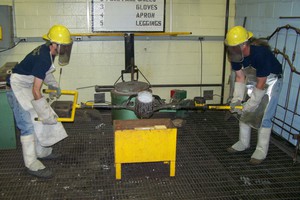Molten to mold: Furnace used to heat metal

CHADRON – A furnace in the Burkhiser technology complex, unused for five years following the discontinuation of the Industrial Technology program, has been dusted off and put to use heating metal for sculptures.
Discussions between Rod Clause, art instructor, and Phillip Colella, a senior majoring in art, about the possible repurposing of the furnace and the benefits of making metal sculptures led to consultations with Richard Bird and Dr. Jim Margetts about starting up the foundry and how it could benefit the art program.
Eventually Clause fired up the natural gas furnace May 6 and melted about 2 ½ pounds of aluminum. He used a 10-pound container called a crucible and poured the liquid aluminum into molds with Colella’s assistance.
The aluminum heated to 1223 degrees Fahrenheit, the ideal threshold for pouring, in about 45 minutes. Clause said he checked the temperature of the molten aluminum with a long-handled tool called a pyrometer.
“It’s exciting when you’re pouring. It’s safe. We have fire suits, helmets, glasses and gloves,” Clause said. “It is a good thing for students to learn.”
Clause and Colella poured the molten aluminum into a traditional investment mold made of plaster and sand surrounded with chicken wire.
Colella said the art and science of pouring metal is never going away.
“We’re always going to be using metal casting for automotive parts and for art,” Colella said.
Clause said once the aluminum has cooled enough to handle, the artist removes the mold, and cuts off the vents and the sprues, or openings through which the aluminum was poured.
The complete casting process starting with the clay sculpture through to a finished metal piece involves 17 steps, according to Clause who has worked in various capacities at foundries in Loveland, Colorado.
Category: Art, Campus News, Student Awards & Achievements

